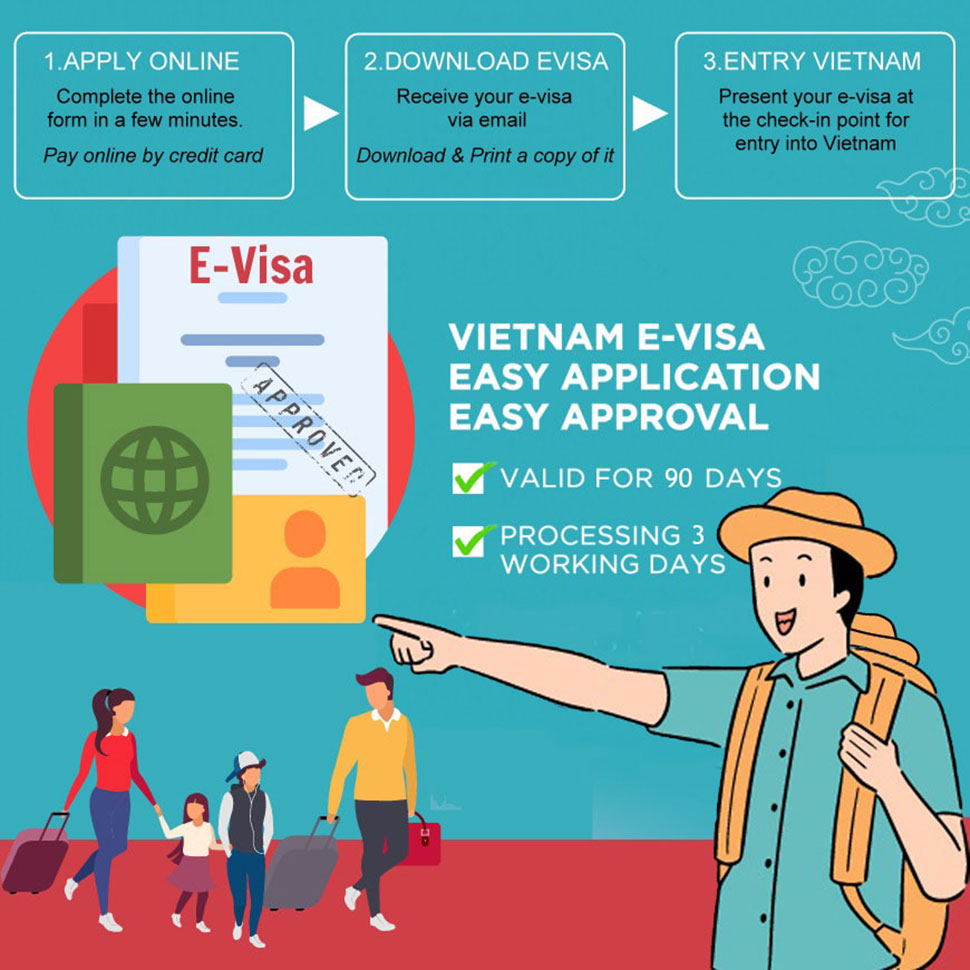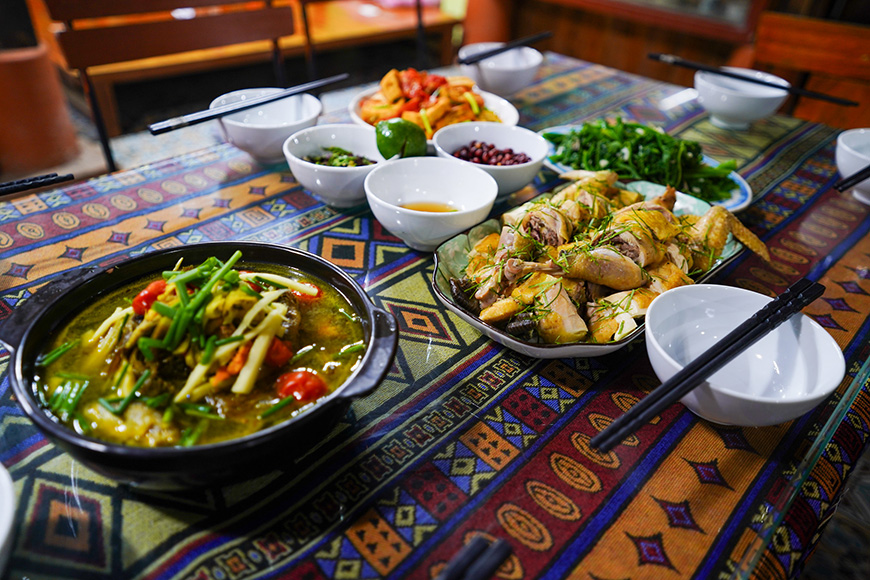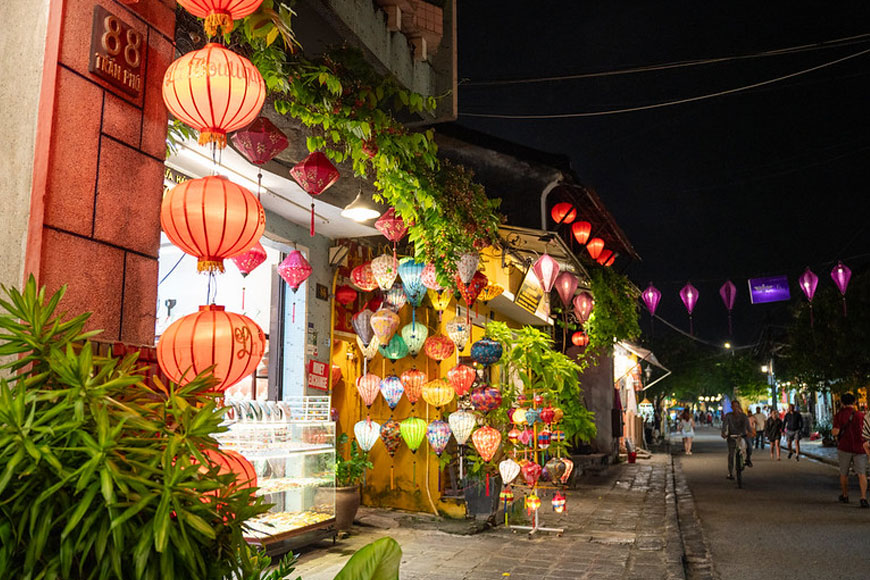
This Vietnam Travel Guide have been updated on 15/08/2023, as the the Government decided to grant electronic visas (e-visas) to citizens of all countries and territories entering Vietnam from August 15.
VIETNAM TRAVEL GUIDE :
The Climate
Vietnam's geographical shape and position mean that different parts of the country can experience very different weather at the same time of year. The country's long shape stretches vertically from the subtropical regions in the north of Vietnam to the tropical regions in the south. This makes Vietnam a year-round destination with at least one part of the country experiencing good weather at any time in the year.
The north of Vietnam tends to be cooler and drier from November to April and hotter with a higher chance of rain from May to September. The hottest time of year in Hanoi is from June to August with an average of 29 degrees centigrade, and the coldest months are January and February with an average of 17 degrees centigrade.
The central regions are warm year round and, in general, see less rain than the southern regions but can be hit with typhoons from August to September.
The south of Vietnam experiences warm temperatures year-round with the monsoon season from April to November and the heaviest rainfall from June to July. The hottest time of year in Ho Chi Minh City in April with an average of 30 degrees centigrade, and the coldest months are November to January with an average of 27 degrees centigrade.
► Read also : When Travel To Vietnam ?
TRAVEL GUIDE VIETNAM:
Visa Requirements
On June 25, 2023, the Vietnamese government approved the extension of Electronic visa (E-visa) and the duration of Visa exemption for foreigners.
On august 15, 2023, Vietnamese government decided to grant the e-visa to citizens of 80 countries and territories entering Vietnam. The e-visa period of stay is now 90 days and allows for multiple entries. On the same way, it is now possible to stay 45 days in Vietnam (formerly 15) for citizens from the 13 countries which are unilaterally exempted from visas by Vietnam.
Note that Vietnam also offers visa exemptions of varying lengths from 14 days to 90 days to citizens of Myanmar, Brunei, The Philippines, Thailand, Singapore, Malaysia, Laos, Kyrgyzstan, Indonesia, Cambodia, Panama, and Chile. If not clear for you, please check with your embassy.
Applying e-visa online
Please apply for Vietnam e-visa only on the OFFICIAL WEBSITE of the Public Service Portal on Ministry of Public Security ! Subscribe first then follow the on-screen instructions. Please note that the fees are 25 USD or 45 USD depending of your stay, and the application is generally processed in 3 working days.
You can find the 80 countries that allowed e-visa issuing here. And list of countries that are exempted of entre visa to Vietnam is here.
If you are not from one of these countries or you wish to apply for a longer visa or a multiple entry visa, you will have to apply through the traditional method of contacting the embassy or through a third party. Mr Linh’s Adventures can help you to arrange visas at a reduced cost for visitors who book one of our tours. Applications must be made to us no later than 14 days before travel. Please contact us for the most recent information.
► How to book your tour in Vietnam?
► Create your own adventure experience

TRAVEL GUIDE VIETNAM:
Arrival/Departure
Vietnam’s Ministry of Health no longer requires travelers to show any Covid-19 vaccination certificate, or undergo any test or quarantine upon arrival in Vietnam.Nevertheless, travelers need to hold a valid visa to be allowed entry, as well as carry medical or travel insurance with a minimum coverage of 10,000 USD for Covid-19 treatment

Hoan Kiem Lake - Hanoi ©Mr Linh's adventure
TRAVEL GUIDE VIETNAM:
Vietnam Travel Tips
What to pack
This depends largely on the region you plan to visit and the season. In general, lightweight, comfortable, fast-drying clothing is a good option. If you are visiting in the cooler months, especially if you are in the north of Vietnam, it is advisable to bring some warmer clothes. Comfortable shoes, walking boots or sandals are all good options for footwear, but this again depends on your itinerary. If you plan on doing any trekking, we advise you to bring some sturdy walking boots.
Some places such as temples or pagodas require you to cover your legs and shoulders so please remember to pack some suitable clothing as you may be denied entry if not dressed appropriately. You may also wish to pack mosquito spray, sunscreen and any other pharmaceuticals you wish to bring from home although these are readily available in most pharmacies and in some shops.
Food and drink
Rice and noodles are the staples of the Vietnamese diet. They are often served with meat, seasoned vegetables, pickled vegetables, and aromatic herbs. These dishes are often served with broth, either as part of the dish or in a separate bowl.
There is also a large ion of high-quality international restaurants in the main cities and in some of the more popular tourist destinations. We advise that you avoid drinking the tap water or any ice that has been made with tap water and stick to bottled water which is easily available and very cheap. Please remember to drink plenty of fluids especially in the hot season or if you are taking part in physically demanding activities.

Vietnamese food © Mr Linh's adventure
Currency
The Vietnamese dong is the country's currency. It is made up of the following denominations of notes: 1000, 2000, 5000, 10,000, 20,000, 50,000, 100,000, 200,000, and 500,000.
Most major shops and restaurants will accept US dollars but can sometimes be fussy about the quality; they prefer clean crisp bills and may refuse any notes with signs of damage.
Although it is primarily a cash economy, certain larger hotels, major shops, and restaurants take Visa and Master Card.
ATMs can be found throughout most major cities and smaller towns tend to have one or two, but be prepared with cash if you are heading out into the more remote areas.
At the time of writing this guide, the exchange rate is 23,410 VND to 1 USD and 23,856 VND to 1 EURO.
Health requirements
At this time, the Vietnamese government does not require any vaccinations before entering the country, although there are some recommended vaccinations and medications you should consider before traveling to Vietnam. As well as your routine vaccinations from your home country, it is recommended that you receive vaccinations for Covid-19, diphtheria, hepatitis A, tetanus, and typhoid prior to travel. Other optional vaccinations are cholera, hepatitis B, Japanese encephalitis, and rabies.
Mosquitos are also prevalent throughout the country and although mostly low risk, it is best to try to avoid being bitten to reduce the risk of mosquito-transmitted diseases such as dengue fever and malaria.
Furthermore, Vietnam has reported cases of the Zika virus which has been known to affect the unborn babies of those infected. Pregnant women or those trying to become pregnant should first discuss traveling to Vietnam with their doctor. Please remember to bring an ample supply of any medical supplies you may need and remember to obtain the appropriate certification from your doctor to allow you to travel with those supplies.
Please contact your local government for the most up-to-date information and recommendations.

Traditional festivities in Vietnam © Mr Linh's adventure
TRAVEL GUIDE VIETNAM:
Culture & Etiquette
The official language of Vietnam is Vietnamese although many of the ethnic minority groups of Vietnam have their own distinct language. French, English, Chinese and Russian are the most widely studied throughout the country. The majority of the population of Vietnam are Viet or Kinh, making up 87% of the population. There is a total of 54 ethnic groups in Vietnam. Approximately 85% of the population identify as following Vietnamese folk religion or Buddhism with the other most prevalent religions being Catholic and Cao Dai. The Vietnamese people, on the whole, are very hospitable and will do everything they can to make you feel comfortable and welcome in Vietnam. It is not uncommon to be invited to meet someone's family or to join them for a drink.
Many of the social rules are based in Confucianism and are centred around showing respect. Shoes should be removed before entering someone's home or when entering a temple. Body language also plays in important part: everything should be given and received with both hands, you should not touch the head of another adult, and you should not point with just one finger but with your whole hand. When eating, chopsticks should not be stood up in food as this resembles the incense ritual performed at funerals. Tipping is not compulsory, but it is always greatly appreciated.

Romantic Hoi An, by night © Mr Linh's adventure
TRAVEL GUIDE VIETNAM:
Holidays
- January 1st- New Year's Day
- Last day of last lunar month-5th day of 1st lunar month- Tet Nguyen Dan
- 10th day of the 3rd lunar month- Hung Kings Commemoration
- May 1st - International Labor Day
- April 30th - Reunification Day
- September 2nd - Independence Day
TRAVEL GUIDE VIETNAM:
Electricity
The plugs used in Vietnam are type A, type C and type F. The majority of the country uses 220 volts but some places use 110 volts. Depending on your home country you may need to use either an adapter or a voltage converter. Vietnam can also sometimes experience power surges and power cuts.

More infos here :
► Why travel with Mr Linh’s Adenture?
► For more information, please visit www.mrlinhadventure.com
SaveSaveSave